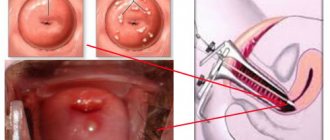Obstetrician-gynecologist, ultrasound doctor, pediatric gynecologist.
Area of professional interests: sexually transmitted infections, cervical diseases, planning and management of pregnancy, contraception, ultrasound diagnostics, gynecology of childhood and adolescence.
For most women, brown discharge that appears on their underwear raises concerns about women's health. But there is not always cause for concern.
Vaginal discharge with a brownish tint can appear both due to illness and under the influence of physiological factors. In addition to the changed color of the discharge, you need to pay attention to the consistency, odor and accompanying symptoms.
Why do women have light or dark brown discharge from their vagina?
When brown discharge appears, then before looking for a disease, it is worth analyzing why the vaginal secretion has changed. The cause may be physiological factors:
- starting to take hormonal contraceptives;
- vaginal trauma (gynecological examination, rough sex);
- ovulation (the follicle ruptures and the egg is released);
- implantation of the embryo into the uterus (pregnancy);
- heavy physical activity;
- premenopause;
- days before and after menstruation;
- establishment of the menstrual cycle in teenage girls;
- hymen rupture after first intimacy.
Brown vaginal discharge that occurs for physiological reasons is not abundant, short-lived and does not cause deterioration in well-being. Pathology can be suspected in the following cases:
- discharge appears with a dark brown tint without connection with external factors (intimate contact, examination by a gynecologist);
- brownish vaginal mucus is discharged profusely;
- your health worsens due to pain, itching or fever;
- The secretion smells unpleasant.
The reason why brown discharge occurs may be hormonal disorders, tumors, erosions or inflammatory diseases of the reproductive system.
If brownish mucus appears frequently, then this is a reason to be examined by a gynecologist. Consultation with a doctor will reveal pathology or confirm that brown secretion occurs under the influence of physiological factors.
Brown discharge in women: norm and pathology
Under certain conditions, the causes of brown discharge in women are not associated with pathology. Brownish vaginal fluid with mucus can be caused by:
- inaccurate or prolonged sexual intercourse;
- rupture of the follicular sac during ovulation;
- conception;
- beginning of pregnancy;
- postpartum recovery;
- adaptation to birth control pills;
- intense physical activity or sports;
- stabilization of the girl’s monthly cycle;
- preparing the body for menstruation;
- release of the remaining endometrium after menstruation;
- premenopause and menopause.
All these conditions have one common symptom - weak brown, moderately liquid, spotting discharge. A small stain remains on the panty liner - about 4-5 cm. The exception is the period after childbirth, when the reproductive system can secrete a larger volume of secretion. Read the article at the link about how long discharge lasts after childbirth.
During the fertile period or ovulation, blood may appear in the abundant mucous fluid of the cervical canal. At first, the vaginal secretion is transparent, but after the rupture of the follicle in which the egg matures, the mucus may darken due to the ingress of coagulated blood, acquiring a brown tint. Normally, the liquid should have the following characteristics:
- Insignificant volume.
- Smearing character.
- Light brown color of discharge (see photo).
- Duration up to two days.
- No unpleasant odor, pain or feeling of tension in the ovarian area.
Spotting
It is imperative to go to the hospital if such a situation occurs constantly, the general condition worsens, and brownish secretion appears before and after ovulation, without interruption turning into menstruation.
Before your period
A few days before monthly bleeding, a girl may notice traces of slight brown mucous discharge on her underwear or daily routine. This phenomenon is isolated. The fibrous structure of the secretion should not be scary, since this is how the body signals the beginning of the process of rejection of the mucous layer of the uterus.
Prolonged spotting of a brownish or dark burgundy hue a week before menstruation can be caused by:
- stress;
- improper diet;
- strict diets;
- overweight;
- wrong lifestyle;
- lack of sleep;
- smoking, drugs and alcohol;
- constant physical overstrain;
- severe hormone deficiency.
Brown discharge between periods in most cases indicates a menstrual irregularity or the presence of pathology. A particularly dangerous symptom is the unpleasant odor of the secreted fluid and constant pain in the abdomen and lower back.
After menstruation
Spotting after menstruation is normal. This condition is caused by gradual detachment of the endometrium, the last fragments of which come out in the form of clotted blood. Most women experience a small amount of brown or brown discharge for no more than two or three days, and a regular panty liner is sufficient.
Dark brown or brown vaginal secretion that resembles menstruation and lasts more than one week should definitely alert you. Cause the problem of hormonal imbalance, inflammation, infectious disease and other pathologies of the reproductive system.
It happens that brown discharge occurs during a delay in menstruation. Follow the link to find out what this sign indicates.
For pregnancy to occur, the fusion of male and female reproductive cells is not enough. Conception is said to have taken place when a fertilized egg is implanted into the uterine cavity. This process in the reproductive system can cause the appearance of scanty brown or pink discharge. But they are observed only for a few hours or days.
Spotting pink-brown discharge
There should not be a lot of brown mucus from the genital tract, since implantation damages a small number of blood vessels. Some women do not have such an early sign at all, so secretion with the blood does not always mean pregnancy.
Brown discharge in women after ovulation 6-12 days can indicate fertilization. The time interval depends on the individual characteristics of the organism.
Additional symptoms:
- swelling and tenderness of the mammary glands;
- frequent urge to go to the toilet;
- increased drowsiness;
- sudden mood swings;
- dizziness and fatigue.
When you start using oral contraceptives or an intrauterine device, your body gradually adapts to the contraceptive. The adaptation period can last about three months, accompanied by minor bleeding between periods.
In this situation, it is necessary to pay attention to the discomfort, as well as the specific period of the cycle when this or that vaginal secretion occurs. A woman can cause dark vaginal discharge:
- skipping a pill;
- violation of instructions;
- taking a large dose of the drug;
- the wrong type is OK.
Without serious knowledge of gynecology, it is difficult to independently determine why there is brown discharge, and there is significant discomfort and pain in the lower abdomen. But a woman can pay attention to the following signs, which should prompt an immediate visit to the gynecologist:
- The bloody secretion is too thick or watery.
- The amount of fluid released increases each time.
- The gasket gets wet in less than an hour.
- Blood is noted in the mucus systematically.
- Sexual contact is accompanied by pain.
- There is a high body temperature for no reason.
- There is an unpleasant odor.
- There is itching and burning sensation.
- There are no periods for a long time.
- A large number of clots are observed during pseudomenstruation.
Often the pathological condition of the reproductive system manifests itself by the release of a large amount of secretion with blood. However, gynecological pathologies do not always make themselves felt with clear symptoms, so they can be mistakenly correlated with the consequences of stress, starvation, inaccurate coitus and other relatively harmless provocateurs.
This secretion may occur instead of menstruation. This is a scanty spotting secretion (up to 50 ml), which is accompanied by the following symptoms:
- lower back pain;
- feeling of tightness or pain in the chest;
- shadow the lower abdomen or suprapubic area;
- dizziness;
- nausea.
The symptom may be caused by the following reasons:
- Hormonal disbalance.
- Pituitary dysfunction.
- Endometrial injury.
- Consequence of abortion.
- Protracted inflammatory process.
- Improper functioning of the endocrine system.
- Strong physical activity.
- Exhausting sports.
- Beginning of pregnancy.
The appearance of copious dark brown discharge cannot be associated with normal processes in the body. A similar sign indicates:
- inflammatory processes;
- sexual infections;
- ectopic (ectopic pregnancy);
- threat of miscarriage (from the first to the third trimester);
- endometritis;
- cystitis;
- endometriosis;
- cervical erosion;
- polyps;
- endometrial hyperplasia;
- benign neoplasms;
- cancer.
Diseases may not be diagnosed for a long time because symptoms do not appear immediately. A woman may not be aware of the pathology and may not observe any obvious signs. The appearance of dark brown discharge often indicates an already advanced case, which will be much more difficult to treat. It is for this reason that you should visit a gynecologist every six months without a good reason, and immediately if you have unnatural symptoms.
Problems with pregnancy and malignant tumors are considered especially dangerous, because in these situations there is a threat to the patient’s life without timely treatment or surgical intervention.
Cystitis
When the urethra or bladder itself becomes inflamed, blood is released, which is not related to diseases of the reproductive system. After frequent urination, a woman not only notices bloody discharge from the urethra, but also painful sensations in the lower abdomen or lower back. Additional symptoms of urethritis resemble the common cold. The following symptoms and characteristics of the secreted fluid should alert you:
- the appearance of blood in the urine;
- frequent urge to urinate;
- cloudy urine;
- high body temperature;
- vomiting and nausea.
Infection of a woman's genital organs in the absence of timely treatment causes prolonged inflammatory processes. Such violations affect the quantity and shade of vaginal secretion. To prevent complications, women need to know the nature of dangerous brown discharge and what infections they occur with.
- chlamydia;
- gonorrhea;
- trichomoniasis;
- candidiasis (thrush);
- genital herpes;
- mycoplasmosis;
- ureaplasmosis;
- bacterial vaginosis;
- gardnerellosis.
The occurrence of these diseases can be asymptomatic until the infection provokes inflammation. Each type of pathology has its own symptoms, but in any condition, brown vaginal discharge is a serious reason to visit a doctor and take a smear for microscopic examination.
Dark discharge can be considered normal or indicate the development of a pathological process in the body. In case of any ailments, you should consult a specialist and under no circumstances self-medicate. Only based on the results of the examination and tests, the doctor will prescribe effective treatment.
Pathological spotting in the middle of the cycle is accompanied by certain symptoms. This may include thick white discharge, yellow discharge with heterogeneous consistency, runny leucorrhoea, spotting that develops into heavy bleeding. They are complemented by: a specific smell, burning and vaginal itching, pain in the lower abdomen, pain in the side radiating to the lower back, fever, nausea, and in advanced cases, vomiting. Such discharges can be conditionally divided into two groups depending on the reason for their appearance.
- Erosion of the uterine cervix is an inflammatory process of tissue, the main symptom of which is periodic bleeding, from spotting to heavy. They are often indicated after sexual intercourse and between menstruation. For many, the pathology is asymptomatic. Erosive destruction of tissue increases the risk of infection. Therapy uses medications, laser, radio waves, cryodestruction, diathermocoagulation, chemical coagulation, and electrical excision. Small affected areas are most often left untreated and monitored periodically.
- Endometriosis is a pathological benign process of tissue growth outside the uterine lining. It manifests itself as spotting and heavy bleeding, prolonged critical days at the beginning, middle, and end of the cycle, pain in the lower abdomen, shifts in menstruation, and painful sexual intercourse. It can be eliminated by electrotherapy, laser, ultrasound, surgical curettage, and combined treatment with medications.
- Endometritis is inflammation of the surface layer of the endometrium. Spotting brown, pink, purulent discharge in women, including in the middle of the cycle, is the main designation of pathology. It is characterized by increased temperature, nagging pain in the lower part of the peritoneum, radiating to the side, and painful sexual contact. For treatment, anti-inflammatory and antibacterial tablets or broad-spectrum antibiotics are prescribed.
- Polyps and neoplasms of various etymologies are characterized by bleeding after menstruation (in the first half of the cycle). Like any pathological changes in uterine tissue, they lead to periodic heavy bleeding. These symptoms are accompanied by pain, general weakness, and nausea. Treatment depends on the etymology and stage of the disease.
- During pregnancy, brown spotting along with pain and cramps indicate fetal fading, threatened miscarriage, as well as ectopic pregnancy. If a sign is detected, you should immediately consult a doctor to remove the dead embryo to avoid infection of adjacent tissues. Sometimes a fetus with blood leakage can be saved. An ectopic pregnancy must be removed urgently, as it threatens to rupture the fallopian tube.
What does the consistency of the discharge mean?
When finding out the causes of brown discharge, the doctor looks at the vaginal secretion on the pad to determine the consistency. This suggests possible deviations in the functioning of the female body.
Spotting
Short-term spotting brown discharge can appear when the follicle ruptures and the egg is released, when the embryo attaches inside the uterus, or after physical exertion. If the symptom persists for a long time, then the cause of brown spotting in women is genitourinary pathology:
- malignant neoplasms;
- myoma;
- rupture of an ovarian cyst;
- uterine polyps;
- endometriosis;
- ovarian apoplexy.
The cause of a brownish “smudge” may be a change in hormonal levels, provoked by taking contraceptives, hormone-based drugs, or a disease.
Mucous
Brown mucous discharge appears when clotted blood enters the vaginal secretion. The appearance of a symptom a couple of days before menstruation and within 1-3 days after is considered normal.
The appearance of brownish mucus on underwear that is not associated with the beginning or end of menstruation indicates minor leakage from the uterus or vagina. The symptom is provoked by:
- endometrial hyperplasia;
- polyps;
- erosion;
- cervical dysplasia;
- neoplasms.
Thick
Brown discharge is a mixture of vaginal secretion and coagulated blood. The cause of the thickness is the difficulty in the outflow of bloody discharge. An obstacle to the free release of brownish discharge may be:
- endometrial hyperplasia (pathological folds appear inside the uterus where menstrual blood accumulates);
- tumors;
- inflammation of the genital organs.
Thick brown discharge occurs with hormonal disorders due to a decrease in the secretory function of the vagina.
Liquid
Normally, the “wateriness” of vaginal secretion increases before menstruation, in preparation for ovulation, or during sexual arousal due to increased mucus production. The entry of a small amount of blood into the vaginal discharge of a healthy woman is caused by:
- rupture of the follicle when the egg is released;
- embryo implantation;
- premenstrual touch-up.
In these cases, the discharge is light brown, does not smell and does not cause discomfort. If a smell or additional symptoms appear, then this is a sign of a disease.
With clots
Brown discharge with clots almost always indicates a pathological process:
- benign tumors;
- endometrial polyposis;
- imbalance of hormones;
- ectopic pregnancy.
When treating iron deficiency anemia, brown discharge appears in women after taking B vitamins and iron supplements. Reddish or brownish secretion indicates an oversaturation of the body with vitamins and microelements.
Pink discharge 10 days before period
Pink discharge before your period is considered normal, but only if it lasts a couple of days and not a week. Almost every woman has encountered them at least once in her life. For many, this phenomenon occurs in every menstrual cycle, for others only at a young age.
Pink discharge before menstruation is a mixture of blood with clear mucus and a woman’s natural lubrication. The color depends on the ratio of blood and clear secretions. This is how you get one or another shade of pink. The presence of vaginal secretion determines the intensity of the pink color.
The reasons for the occurrence of pink discharge 10 - 14 days before menstruation can serve as a sign of the onset of ovulation. In medicine, such discharge is called ovulation. Their appearance 10 days before the start of the cycle is normal, if they do not have any side symptoms and do not bring discomfort or discomfort to the woman.
For many women planning to have a child, such discharge can serve as a reason for planning conception. These days are considered favorable for egg fertilization.
The appearance of ovulation discharge 10 days before menstruation occurs due to the fact that when the egg leaves the follicle of the ovarian tissue, the uterine mucosa prepares to attach it to the walls of the fertilized egg. During this process, copious amounts of estrogen are released. It is a sharp increase in hormone levels that can lead to minor blood loss.
But it is also worth remembering that 10 days before your period, during ovulation, conception itself can occur. And, of course, the fertilized egg, attaching to the swollen wall of the uterus, can create microcracks or disruptions of the uterine wall. This releases a certain number of drops of blood, which subsequently appear pink. This behavior of the female body can become an early symptom of pregnancy.
Pink discharge may indicate ovulation
Pink discharge a week before your period
- Gynecologists say that taking hormonal contraceptives or other types of protection against unwanted pregnancy can provoke changes in hormonal levels in women a week before menstruation and, as a result, provoke the appearance of pink discharge. This phenomenon occurs in 10% of women and is normal in the first months of using the drugs. Pink discharge before menstruation may occur due to the presence of an intrauterine device. A week before your period, your hormonal levels change dramatically, which, when wearing an IUD, can cause blood leakage. This is why you may also have pink blood discharge in this case.
- It may not be strange, but even when taking oral contraceptives, which are considered more harmless than the intrauterine device, there may also be discharge a week before the menstrual period. The reasons for the deviation will be the same. All this is absolutely harmless to your health.
- Even sexual intercourse can cause discharge. This happens due to a discrepancy between the sizes of the man's penis and the woman's vagina, or due to excessive intensity of penetration. Maybe the position was chosen incorrectly, which caused the appearance of microcracks. They will bother you for a few days, and then they will end.
One of the consequences of taking hormonal contraceptives is pink discharge
Pink discharge when delayed
Make sure you are not pregnant. After all, if there is a delay, first of all it is worth talking about pregnancy, and then about possible deviations in its absence. If you are still pregnant and have pink discharge, you should immediately consult a doctor. Rather, it is a small fraction formed as a result of implantation of the fertilized egg in the uterine cavity. But there may also be leakage of fluid and a possible threat of pregnancy failure. Having determined the reasons, carry out a series of harmless manipulations to preserve the health of the mother and child.
Also, do not panic if the reasons are related to an examination by a gynecologist.
During pregnancy, scanty vaginal discharge is considered normal after palpating the woman’s condition. But, if pink smudges last a couple of days, you should consult your doctor again for advice. It is important to remember that frequent examinations by a doctor can become a pretext for threatening miscarriage.
Alarming symptoms
It is generally accepted that pink discharge is a natural phenomenon of a woman, which by its nature is harmless to her body. But there are cases when they indicate serious deviations in women's health. What could be a reason for concern?
- Pain in the back and lower abdomen.
- Change in intensity and saturation.
- The appearance of turbidity with admixtures of pus.
- Curd discharge.
- Unpleasant smell.
All these symptoms can be the cause of such deviations as:
- cervical erosion;
- inflammatory processes;
- genital tract infections;
- advanced pathological diseases.
The sooner you identify the causes of pink discharge, the easier it will be to carry out the correct treatment.
If there are corresponding symptoms, you must immediately contact the antenatal clinic for diagnosis and prescription of the correct treatment regimen.
Bleeding between menstrual periods for unknown reasons is the most dangerous. The essence of all treatment is to eliminate not only the symptom, but also the cause of a particular disease. Each woman has an individual length of her menstrual cycle. The norm is a cycle from 22 to 35 days. The menstrual cycle refers to the period from the first day of menstruation to the first day of the next menstruation. The duration of menstruation ranges from 3 to 7 days. For some women, their periods begin with brown discharge, which intensifies and becomes dark red on the second and third days, after which it also gradually stops.
There are often cases when spotting appears in the middle of the cycle. Bloody discharge between periods is called metrorrhagia. Although this phenomenon is not considered the norm, the reasons why they appeared are understandable. Of course, if the bleeding between periods is very heavy, you should not look for an explanation on your own. In such a situation, do not wait to see a gynecologist, but call an ambulance. The discharge is considered heavy, in which a woman has to change the pad every 1-1.5 hours.
If the discharge in the middle of the cycle is not abundant, there is no need to panic. This does not always indicate a serious pathology. Even a little stress, anxiety, or climate change can trigger menstruation ahead of time. Blood between periods can occur on any day of the cycle. But most often women notice that this phenomenon is typical from the 10th day after the start of menstruation. In this case, the discharge can be both scanty and abundant.
Lower abdominal pain
The combination of brown discharge and pain in the lower abdomen is always a sign of a pathological process. The appearance of a symptom may indicate the following conditions:
- inflammation of the appendages and uterus;
- oncological process;
- endometrial polyposis;
- rupture of an ovarian cyst;
- genitourinary infections;
- erosion;
- adenomyosis.
Pain, depending on the type of pathology, can be insignificant or cause excruciating discomfort. But any pain, even minor, requires a medical examination to identify the cause.
Character of the smell
Some girls mistakenly believe that if the brownish secretion does not smell, it means there is no disease. It is not always so. With pathological processes in the genitourinary area, vaginal secretions may have a characteristic smell, or may have no odor at all.
Unpleasant
Brown discharge with an unpleasant odor often indicates gynecological diseases:
- salpingo-oophoritis;
- endometritis;
- bacterial vaginosis;
- colpitis;
- neoplasms.
Dark brown discharge that smells rotten occurs during a frozen pregnancy or ectopic attachment of the fertilized egg. Sexually transmitted diseases are accompanied by the appearance of a brownish secretion with a foul odor. Another reason why vaginal discharge smells unpleasant is a change in hormonal levels or metabolic disorders.
Frozen ectopic pregnancy
Sour
Brown discharge with a sour odor is characteristic of thrush. A brownish tone in the secreted secretion appears when a fungal infection is complicated by pathological changes in the body:
- hormonal abnormalities;
- cancer;
- inflammation of the reproductive system.
Light brown discharge appears when chronic diseases worsen against the background of candidiasis.
Without smell
Short-term, odorless brown discharge often appears under the influence of physiological factors:
- damage to the vaginal mucosa;
- ovulation;
- conception (embryo implantation occurs);
- days before and after menstruation;
- the beginning of menopause.
A long-term, odorless, brownish secretion indicates fibroids, endometritis and benign tumors.
When bloody discharge is not a sign of disease
In some cases, the appearance of blood impurities in the discharge is associated with physiological processes occurring during the cycle. Minor damage to blood vessels occurs during a gynecological examination. The cause of normal pinkish leucorrhoea may be minor hormonal imbalances and other factors.
Physiological processes
Ovulation.
By the middle of the cycle, the maturation of the dominant follicle ends. It reaches its maximum size and then bursts. The egg emerges from the shell and fertilization becomes possible. Leucorrhoea briefly (for 1-2 days) acquires a faint pink or brownish color due to droplets of blood from damaged follicle vessels entering the vaginal mucus.
Implantation of a fertilized egg
into the lining of the uterus. Pregnancy occurs after ovulation for 1 day, while the egg is viable. Over the next few days, the fertilized egg moves into the uterine cavity and attaches to its wall. During implantation, endometrial capillaries are damaged. As a result, a woman develops scanty pink leucorrhoea about a week before her expected period. If implantation is unsuccessful (the embryo is attached, for example, too close to the cervix), then the fertilized egg peels off and the pregnancy is terminated. After this, your period comes with a slight delay.
Gynecological procedures
A pinkish or brownish color appears in leucorrhoea due to accidental damage to small blood vessels in the genitals during diagnostic and therapeutic procedures:
- Gynecological examination using speculum, ultrasound probe or colposcope. Such examinations are usually carried out in the first phase (approximately 7-12 days of the cycle), so that the discharge in the middle takes on a normal appearance after a couple of days and there is no damage left by the beginning of the next cycle.
- Taking a smear from the vagina and cervix. This scrapes off a small layer of mucous, causing slight damage to the surface. Leucorrhoea may have a reddish tint for several hours after the procedure.
- Curettage of the uterine cavity, biopsy of the cervix and uterine cavity.
Age-related changes in hormonal levels
Bloody discharge in teenagers
appear between periods during the first two years after the onset of puberty. Along with other menstrual cycle disorders characteristic of this period, spotting occurs due to hormonal shifts occurring in the body of a teenage girl. Its cause is the immaturity of the ovaries.
Bloody leucorrhoea during menopause.
They also appear due to natural hormonal imbalance. But it only arises due to the aging of the body and the completion of the functioning of the ovaries. Discharge in the middle of an irregular cycle appears during perimenopause, which precedes the complete disappearance of menstruation.
Warning:
It must be borne in mind that such discharge also appears as a result of serious diseases. Moreover, after 45 years, the risk of pathologies increases. Therefore, women need to undergo a preventive gynecological examination at least once a year.
Other causes of hormonal shifts
Even minor deviations in the ratio of sex hormones affect the functioning of the female reproductive system. The reason for the shift may be the following factors:
- The use of hormonal drugs for the purpose of treating infertility or menopause. The use of such products leads to menstrual irregularities and the appearance of bleeding in the middle of the cycle.
- A woman finds herself in a stressful situation associated with overwork and strong emotions. Stress affects the production of hormones in the body, resulting in disturbances in the functioning of the reproductive organs.
- Lack of vitamins due to poor nutrition. In addition to the fact that vitamin deficiency disrupts the production of hormones due to a lack of necessary elements, cell regeneration is also hampered. As a result, pathological processes occur in the tissues of the genital organs. The structure of blood vessels changes, which leads to the appearance of blood impurities in the leucorrhoea.
- Metabolic disorders, obesity.
- Use of hormonal contraceptives. In the first 2-3 months after starting to take them, the appearance of bleeding between periods is quite possible. In this case, there are no unpleasant symptoms, the discharge disappears after the body has fully adapted to the new hormonal background. If the spotting does not disappear, you need to change the contraceptive. You may need to be tested for medical conditions.
- Installation of an intrauterine device. In this case, not only a change in hormonal levels occurs, but also mechanical damage to the mucous membrane.
Addition:
Bloody discharge in the middle of the cycle appears in women who have reduced blood clotting, as well as in those who take blood thinning medications.
Video: Pathologies leading to intermenstrual bleeding
If itching is present
Itchy discomfort in the perineum is not always a sign of pathology. Brown discharge and itching may appear for physiological reasons:
- injuries during sex or gynecological examination;
- taking hormonal contraceptives;
- allergies to linen fabric or hygiene products.
But the symptom does not always indicate relatively harmless deviations. When itching and brownish discharge persist for a long time, the development of pathology should be suspected:
- cervical erosion;
- endometriosis;
- thrush;
- sexual infections;
- neoplasms.
Copious discharge
Copious brown discharge is normal during the postpartum recovery period. Gradually, the volume of brownish lochia decreases and disappears, leaving only moderate secretion in the form of clear vaginal mucus.
After an abortion, parts of the damaged endometrium come out of the uterus and in the first days the discharge of mucus with brownish clots can be abundant. Normally, secretion gradually decreases and a “daub” appears, which goes away on its own.
Copious brownish discharge may appear with an ectopic pregnancy, benign neoplasms or polyps.
After examination by a gynecologist
During examination, in addition to gynecological mirrors, other instruments are used that can slightly damage the mucous membrane. A common cause of brown discharge after examination by a gynecologist: vaginal scraping. When particles of the vaginal epithelium are taken, small capillaries may be damaged and drops of clotted blood mixed with mucus. The “daub” that appears is not abundant and disappears quickly.
During hysteroscopy, cauterization of erosion and some other therapeutic and diagnostic procedures that violate the integrity of the mucous membrane of the cervical canal or vagina, the secretion of brownish mucus will continue for several days and will be accompanied by moderate nagging pain in the lower abdomen. This is considered the norm.
During procedures, gynecologists warn patients about possible bleeding and pain.
Spotting after intercourse
“Contact” spotting that appears in a woman immediately or several hours after sex always alarms doctors. This is one of the most common and first signs of cervical cancer. That is why, in the event of such complaints, it is necessary to undergo a full examination in order to identify the pathology in an unadvanced form.
But not only with cancer of the cervix and vagina, brown discharge appears between menstruation; the causes may be hidden in a polyp of the cervical canal or uterine cavity, erosion, an inflammatory process and some others. Only a doctor can finally figure it out after an examination.
Causes of discharge with blood
Brownish secretion with blood spots before or after menstruation is considered normal if it is not accompanied by a general deterioration in well-being. Brown discharge with blood in the middle of the cycle indicates damage to the mucous membranes of the vagina or uterus. Provokes the appearance of symptoms:
- damage to capillaries due to erosion or tumor growth;
- hormonal abnormalities;
- intrauterine device.
The appearance of spotting, bloody-brown secretion in the middle of the cycle may indicate conception or ovulation.
A girl experiences brown discharge during her first intimate contact. Red-brown impurity in the vaginal secretion appears when the hymen ruptures.
Brown and bloody discharge as a symptom of disease
Such symptoms may indicate illness in the following cases:
- bloody or brown discharge appears in the middle of the monthly cycle (for example, on the 16th day of the cycle or the 12th day of the cycle, depending on its duration), while the woman does not take hormonal oral contraceptives;
- with discharge, the lower abdomen hurts, there is dryness, burning, itching in the vagina, the temperature rises, pain is felt during sexual intercourse;
- during menopause or if a woman has had no menstruation for a year now;
- in case of constant discharge after sex.
Bloody issues
A slight admixture of blood in the vaginal secretion, not accompanied by pain and other signs of deterioration of health, appears during natural physiological processes:
- follicle rupture;
- conception;
- beginning of menopause.
A slight bruising occurs in the first month of taking hormonal contraceptives.
Prolonged or heavy bloody discharge indicates vaginal or uterine bleeding caused by diseases or tumors.
In their lives, almost every woman encounters such an unpleasant problem as brown spotting. What causes spotting? When might she appear? What are the causes of spotting? Should I be afraid of this and what should I do?
The content of the article:
The appearance of brown spotting most often should not give a woman cause for concern.
Typically, this spotting discharge is the result of aging intrauterine tissue . This is explained by the fact that for some reason during your last menstrual cycle the regula did not pass on time and, as a result of this failure, the intrauterine tissues aged and began to come out with a brown color.
However, if there is repeated discharge, pay attention to the unusual color and go to a gynecologist for advice . In some cases, spotting may be a symptom of a dangerous disease.
When can such discharge be considered normal?
If during such discharge a woman does not feel any discomfort - there is no unpleasant odor, itching, pain in the abdomen and lower back, then we can say with a high degree of probability that there are no health problems.
- The most common cause of light spotting in the middle of the cycle is a significant increase in a certain hormonal level at the very moment of ovulation. This phenomenon is often spasmodic in nature.
- These discharges can signal that the egg is ready for fertilization. Typically, for most women, ovulation occurs in the middle of the cycle (with a normal cycle), although deviations of several days are possible. During the period of ovulation, women produce large amounts of a hormone such as estrogen, which affects the lining of the uterus. Because of this, minor bleeding may occur, which is not a pathology.
- Perhaps spotting in the middle of the cycle occurs due to the fact that sexual intercourse was too active. Alternatively, the position in which you make love when the cervix is too curved is not suitable for you. Or the vaginal mucosa is injured due to the fact that the partner’s penis is too large for you. This is quite normal, only if bleeding does not occur again in the next cycle (then the reason is different).
- Early pregnancy. When a fertilized egg attaches to the uterine wall, the structure of the endometrium changes inside, it becomes more sensitive and receptive. During this period, minor bleeding may occur in the form of a small reddish or brown spot. In a month, when the woman already understands and realizes her new position, everything should be in order. During a normal pregnancy, there should be no dark vaginal discharge.
It also happens that this problem is visible only during the period of individual hygiene, and absolutely no traces are visible on the underwear. This state of affairs often does not indicate a hormonal disorder, physiological disorders, etc. On the contrary, they only emphasize the normal functioning of the body.
However, if intermenstrual bleeding with blood in the middle of the cycle is intense and does not stop for several days, then you should definitely contact a gynecologist for a qualified diagnosis.
Why can there be spotting instead of menstruation?
For women, it is considered acceptable that certain types of discharge appear from the vagina during menstruation, but it is necessary to distinguish between discharge that is quite positive and signs indicating a specific disease. Normal discharge from the female body includes small transparent clots that are released with menstrual blood and do not cause inconvenience. However, the presence of brown discharge during the menstrual cycle . In this case, you should definitely visit a gynecologist for a check.
The cause of spotting may be endometritis. With this disease, brown discharge may appear at the very beginning and at the end of menstruation. It is also possible for them to appear, accompanied by nagging pain in the lower abdomen and a sharp, unpleasant odor, in the middle of the cycle.
Also, a very common cause of brown discharge can be a polyp in a woman’s uterus , which is formed as a result of hormonal imbalances in the body.
Pathological causes
In other cases, spotting in the middle of the menstrual cycle is a signal of some kind of disturbance in the functioning of the body, so it is better to consult a gynecologist. Let's look at the common reasons that can cause spotting in a woman in the middle of her cycle:
- Endometritis, which is characterized by an inflammatory process of the muscular inner layer of the uterus. The disease could have occurred due to the woman's abortion. The woman may experience pain and fever. When this condition of the patient is not treated, it gradually becomes chronic, and the body gives a signal in the form of a symptom of bleeding.
- The presence of polyps in the endometrium, which can occur after an abortion or cesarean section. The diagnosis here can only be made based on the results of hysteroscopy, ultrasound and histological analysis of endometrial scrapings. This disease is treated by surgical intervention “polypectomy”. After this, to normalize hormonal levels, taking COCs is indicated.
- Contraceptives. Taking hormonal contraceptives leads to disruption of hormone levels in the female body. If the bleeding that appears does not stop within a month, then you need to visit a gynecologist who will change the drug you are taking to another medication.
- Infections of the vagina or cervix. Due to the inflammatory process during menstruation, incomplete rejection of the uterine mucosa occurs, and its remains can be released in the middle of the cycle.
- Hormonal disorders. A normal menstrual cycle is only possible if hormones act on the uterine lining in a balanced manner. When this process is disrupted, the uterine lining becomes a kind of target for hormones. Hormonal imbalances often lead to a woman’s lack of ovulation and, as a consequence, problems with conception.
- Brown discharge in the middle of the cycle may indicate the development of pathological processes in the uterine endometrium (endometriosis). The disease is characterized by the proliferation of endometrial cells outside the uterine cavity, which, if not treated in a timely manner, leads to the formation of polyps, and in the worst case, to infertility. Concomitant symptoms of the disease include severe pain in the lower abdomen, radiating to the lumbar region, general loss of strength, and increased body temperature.
- Wearing an intrauterine device for contraception. In this case, spotting in the middle of the cycle may appear as a sign of infection or inflammation present. Also, this may indicate the presence of a cyst or the appearance of polyps in the vagina or cervix.
- Discharge that occurs in the middle of the cycle may indicate a woman has a uterine tumor. Surgical intervention in this case can only take place if concomitant pathology is identified.
- Stress. The connection between the nervous and endocrine systems in the female body is very close. The hormonal system of the body depends on the nervous and physical state of the woman. Stress leads to the development of overwork, giving impetus to the exacerbation of chronic diseases, and leads to the development of new ones. The resulting hormonal disruptions in the body lead to disruption of the menstrual cycle and the appearance of intermenstrual discharge and even bleeding.
If you discover unusual discharge, there is no need to panic, because in most cases they either do not pose a threat or indicate pathologies that respond well to treatment. Therefore, the best step would be to seek qualified advice, and also do not forget about regular examination. For preventive examinations, 1-2 times a year is sufficient.
The true causes of spotting before menstruation
Every woman who is attentive to her health will pay attention to the appearance of brown vaginal discharge before her monthly cycle. The truism is that daubing is not the norm. A few days before or immediately before menstruation, the appearance of spotting confuses female representatives. What is this? Are the characteristics of the body or some disease making itself felt? An accurate answer will only be given by an examination by a gynecologist after laboratory and instrumental examinations. The main factors that can cause premenstrual brown discharge are:
- contraception . The spotting that occurs while taking oral contraceptives (Jess, Yarina, etc.) is a consequence of changes in hormonal levels and the adaptation of the woman’s body to these changes. In about 30-40 percent of women, brown discharge disappears in the first 3 months from the start of taking contraceptives, and in 5-10 percent of women who protect themselves from unwanted pregnancy in this way, the body’s adaptation can last up to six months. Due to the use of hormonal contraceptives, bloody discharge may occur not only before the regular periods, but also after them and in the middle of the menstrual cycle.
- pre-regulatory spotting may be an undesirable consequence when using an intrauterine device as contraception;
- a disease such as endometriosis is one of the most common causes of brown discharge;
- An option for the cause of bloody premenstrual discharge may be a benign neoplasm in the uterus - endometrial polyp . In addition to spotting, signs of the appearance of a polyp in the uterine cavity include pain in the pelvis, which is cramping in nature, and menstrual irregularities.
Discharge before menstruation
5-6 days before menstruation, due to hormonal changes in the body, a woman may notice that the nature of what is released from the vagina is a little unusual. Leucorrhoea may be cloudy and creamy. They are no longer pale transparent, but white or yellowish, sometimes abundant and watery, but more often viscous and thick.
After taking a smear in the days before menstruation, an increased number of leukocytes , gram-negative rods, and epithelial cells is determined.
A variant of the norm can also be ichorous discharge - ichor appears several days before menstruation, while the woman is not bothered by other unpleasant symptoms.
However, if the white discharge is abundant and prolonged, with an unpleasant odor, sometimes darkish, gray, and the woman is bothered by itching and a burning sensation, we may be talking about thrush .
Many women are interested in how normal dark brown discharge is before menstruation, which for many appears a day, and sometimes even 2-3 days before menstruation. Pinkish or dark discharge before menstruation is absolutely normal, provided that spotting of this color appears on the eve of menstruation. Since menstruation is a consequence of the death of the egg, its release occurs gradually. And if such discharge occurs for no more than one day before menstruation, we are not talking about pathology.
Therefore, you need to know: if you have brown discharge before your period, what it means depends on how long this phenomenon lasts. If it starts about a week before your period, you may suspect that a reproductive system disorder is developing. Therefore, you must definitely visit a doctor.
It should be noted that if instead of menstruation a brown or burgundy smear appears, pregnancy may be suspected. It is known that among the many symptoms that allow one to suspect an interesting situation, there is also a sign of pregnancy - light brown discharge. Sometimes a woman notes that such smears lasted 1 day and ended.
However, to be sure that a woman is expecting a child, an examination with a doctor or a test showing two stripes will help.
Spotting before menstruation begins due to the following reasons:
- hormonal imbalance;
- endometriosis;
- endometrial hyperplasia ;
- climate change;
- stress or severe shock;
- use of hormonal contraception or termination of use;
- uterine polyps.
My period has passed, the spotting has started - what could it be?
Brown discharge in the last days of menstruation is normal if menstruation lasts no more than 7 days . If the “daub” is longer, then it is quite possible that the causes of this are some very unpleasant and dangerous diseases, such as endometritis, endometriosis or endometrial hyperplasia . In healthy women, such post-regulatory discharge may occur as a result of taking oral hormonal contraceptives . Another physiological reason for discharge after menstruation may be the implantation of an embryo into the wall of the uterus , about a week or ten days after ovulation. However, in this case, a definite diagnosis can only be made after visiting a gynecological consultation .
Discharge after menstruation
Normally, black, light brown discharge after menstruation or spotting pink discharge may continue for several days. If you have brown discharge after your period, what this means depends on the duration of this phenomenon. It is normal to have dark brown discharge for three days after the red bloody discharge has ended. When a smear of this color appears, a natural cleansing of the uterus occurs.
But if this phenomenon lasts longer than three days, the reasons why there is bleeding after menstruation should be determined by a doctor whose specialization is gynecology.
The answer to the question of why it bleeds after menstruation or what is the reason for the bleeding after a week can be answered after examination and research. But if it smears brown for a long time or if you start bleeding a week after your period, you can suspect uterine fibroids , endometriosis and other diseases. Therefore, if your period has passed, but there is still spotting, and the same repeated manifestations occur in the next cycle, it is worth getting examined.
Any discharge that appears after menstruation has completely ended should also be a concern. If on the 11th day or 10 days after menstruation, spotting appears again, or at first it is beige, then dark, and then blood, you should immediately consult a doctor.
What causes mid-cycle spotting?
Small brown discharge that can occur 3-7 days after menstruation is quite common. The appearance of daub in this case signals that your egg is ready for fertilization .
If the intensity of the discharge increases and its duration is more than three days , you should visit a gynecologist . And in case of severe bleeding, immediately call an ambulance .
Why does spotting occur in early pregnancy?
In the early stages of pregnancy, spotting may occur, which is very frightening for expectant mothers. It happens that they appear on days when regulations should have occurred.
If the discharge is not painful and short-lived, then there is nothing to be afraid of. Also not dangerous for the woman and the fetus are not abundant and short-term discharges, which are associated with the attachment of the fertilized egg to the wall of the uterus . That is, if more than one week has passed since fertilization.
However, in any case, you should tell the doctor who is observing you about the appearance of brown or any other discharge; he will be able to determine the nature and cause of the discharge.
If right now you do not have a real opportunity to visit a gynecological office, inform the doctor at least by phone about your condition.
Can there be spotting when taking Utrozhestan or Duphaston?
In the early stages of pregnancy, expectant mothers may experience spotting. If the period of conception is no more than 7-10 days , then this may be the body’s adaptation to a new state, which was discussed earlier.
However, spotting can also be a sign of an incipient miscarriage or a decrease in hormonal levels at the beginning of pregnancy. Don’t be lazy, seek help from an antenatal clinic.
After conducting the necessary examination, specialists may recommend taking the drugs duphaston or utrogestan, which are necessary if low levels of progesterone hormones are detected in the body of the expectant mother or as a prophylactic agent to maintain pregnancy .
While taking these medications, slight brown spotting occurs, which should stop soon. Otherwise, you should consult a doctor .
Is spotting after sex normal or not?
After sexual intercourse, a woman may experience slight spotting. The reasons for the appearance of such spotting or minor bleeding can be various factors: mechanical damage or microtrauma during sex; various types of erosion and polyps ; inflammatory diseases such as vaginitis, cystitis, cervicitis; sexually transmitted diseases ; as well as various diseases that are not associated with sexual intercourse itself.
In addition, after sex, spotting may appear due to the presence of a small amount of blood in the partner's sperm .
There are many reasons and factors that can lead to the appearance of brown vaginal discharge and, unfortunately, not all of them are the physiological norm.
Therefore, dear women, in order to protect your health and avoid the negative consequences of such discharge, do not hesitate to contact your gynecologist .
Only a specialist, after conducting the necessary examinations and based on the test results, will be able to give you a diagnosis and the exact cause of this unpleasant phenomenon.
Brown discharge in the middle of the cycle. Day 20 of the cycle signs of pregnancy discharge
Even small spotting that appears from a woman’s vagina between periods indicates that it is necessary to be vigilant and, with the help of a doctor, be sure to understand how dangerous it is and for what reason these symptoms appeared. Brownish brown discharge and mucous discharge streaked with blood, which appear, for example, on the 15th day of the cycle, should also alert you. If these are acyclic manifestations, the development of diseases can be suspected.
According to statistics, slight bleeding or spotting in girls and women during the period between menstruation appears in approximately 80% of cases. 20% of women note that such discharge is not spotting, but copious, and it can appear unexpectedly, or the woman notices that after intercourse there is blood.
It is especially important to pay attention to any discharge during pregnancy. Why women in this position bleed should be found out immediately, regardless of whether there is pain in the lower abdomen or not. You should consult a doctor immediately, as blood or dark discharge in women may indicate a miscarriage.
The causes of intermenstrual bleeding will be discussed below.
Complications and consequences
Brown discharge as a consequence can occur while taking hormone replacement medications, which include their synthesized analogues of the endogenous group: progesterone and estrogen. The side effect of missing a contraceptive is indicated in the instructions for its use. It includes not only the manifestation of skin itching and rashes, but also scanty uterine bleeding.
Practical indicators determine the presence of brown discharge in many patients after surgical correction in the field of female reproductive organs, surgical abortion or aspiration methods of termination of pregnancy. Any intervention procedure during the natural functional process of the female body can have its own complications and consequences.
Discharge after menstruation
There are many reasons for brown discharge between periods, and many of them require treatment. Timely therapy allows you to quickly get rid of the problem without negative consequences. It is worth taking a closer look at the possible causes of brown spotting.
During ovulation
On the 12th day of the cycle, the dominant follicle matures in the ovaries, ready to release a mature cell. During this period, the woman is bothered by copious mucous discharge like egg white. On the 14th day of the cycle, ovulation occurs, when the walls of the mature follicle burst and the egg is released.
If bleeding occurs in the middle of the cycle during the supposed period of ovulation, it is possible that ovarian apoplexy (rupture) has occurred. This can happen with polycystic ovary syndrome, when several follicles grow at once, adnexitis, or hormonal imbalance, as a result of which the corpus luteum does not function properly.
After sex
Minor spotting during sex can occur in any healthy woman. Around the 10th day of the cycle, the level of estrogen in the body reaches its maximum, and the blood vessels become more sensitive, including those in the vagina.
If a representative of the fair sex during sexual intercourse during this period is not very excited and she produces little lubrication, then this can be fraught with abrasions of the external genitalia and vagina.
Slight, rather scanty, brownish discharge after sexual intercourse may also indicate cervical pathology. When the cervix is eroded, it can bleed constantly, and sex will only worsen the problem.
On the 15th day of the cycle, after ovulation, the discharge usually changes its character to white or milky spotting. This happens if fertilization has not occurred and the woman is healthy.
If unprotected sexual intercourse occurs during the fertile window, then approximately within a week before menstruation, the fertilized egg may attach to the uterus.
During the penetration of a fertilized egg into the enlarged endometrium, a small amount of blood is sometimes released, resulting in a brown spotting discharge.
So if a spot is detected during this period, it is worth taking a pregnancy test.
Spotting in combination with cycle disorders sometimes indicates the arrival of menopause. Then, instead of the usual heavy periods, there may be brown spotting, observed from cycle to cycle, the length of which increases until amenorrhea occurs.
When taken OK
The appearance of brownish discharge in the middle of the cycle may be preceded by the start of taking oral contraceptives. This usually happens during the first 3 cycles, then the reproductive system adjusts to a new job, and hormonal imbalances no longer bother you.
If the contraceptive is not suitable, the discharge may last longer and occur not only in the middle of the cycle. Another symptom is feeling unwell. The main thing in such a situation is to remember that stopping taking birth control pills without the knowledge of a specialist can lead to more serious problems, and be sure to contact a gynecologist.
To suspect that bleeding or spotting are pathological phenomena, a woman must clearly know what her cycle should be like. Of course, every experienced representative of the fair sex knows how many days between menstruation is the norm for her.
How many days there should be between menstruation is an individual concept. Some people have a cycle of 30-35 days, for others a cycle of 24 days is normal. However, the average cycle is 28 days. Although from month to month it can fluctuate and be 24-27 days.
How is a cycle counted? It begins on the first day of menstruation and ends with the beginning of the next menstruation. Therefore, if a mature woman experiences something similar to her period after 2 weeks, starts again a week later, or her period comes for the second time in a month, the reasons for this will be determined by a doctor, who should be contacted immediately.
But if a young girl has her period for the second time in a month, this may indicate the formation of a cycle. In such a situation, if your period comes 2 times a month, this is normal. Girls often write about such manifestations on every thematic forum.
However, if the onset of menstruation is several days ahead of schedule, or the interval between periods is several days longer, you should not sound the alarm and take any steps ahead of time. This can happen due to stress, too intense training, fatigue, climate change, etc.
Sometimes the reasons why your period started 10 days earlier are also associated with such phenomena. It happens that the lower abdomen hurts for some time, but menstruation does not begin - a similar phenomenon can also be associated with overexertion or stress.
When determining the causes of bleeding in the middle of the cycle, it should be borne in mind that they can be different. First of all, pinkish or pink discharge, as well as brown discharge in the middle of the cycle, is possible if a woman is ovulating on these days.
If the bleeding in the middle of the cycle is very scanty and spotting, then, in the absence of illness, this may be normal.
In this case, the pink or brown spot will go away on its own and no treatment is required.
It is not so rare for women to notice that they have spotting during ovulation or just a drop of dark-colored spotting. Naturally, ovulation with blood discharge frightens women, making them think that certain negative changes are occurring in the body.
But such manifestations during ovulation may actually be normal, since the walls of the follicle rupture during the release of the egg. Accordingly, microvessels rupture, as a result of which blood discharge appears during ovulation.
When answering the question of how many days such spotting can appear during ovulation, one should take into account the individual characteristics of the body. If the vessels of the fair sex are very thin, then this condition may continue for several days after ovulation has occurred.
As a rule, the daub in this case is brown. Sometimes after ovulation the stomach feels tight, like before menstruation, which is also a normal sensation. As a rule, ovulation occurs on days 10–17 of the cycle.
A woman should not worry that such manifestations will become an obstacle to conception - even if such discharge appears, she will be able to get pregnant. But if this happens more than once, but three or more cycles in a row, progesterone deficiency can be suspected. In this case, it is important to visit a gynecologist.
DETAILS: How to correct flat feet in adults
Source: https://kcdc.ru/beremennost/burye-vydeleniya-v-seredine-cikla.html











